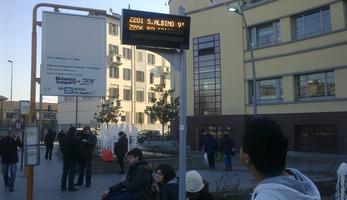Improved traveller information
Thematic areas
Smart, Sustainable, Connected and Shared mobility
Summary
This measure aims to set up a real-time information system for urban public transport users, based on a bus traveller information study.
Implementing sustainable mobility
When the Porta Castello node became operational in 2006, the need to setup an InfoMobility service for Urban Public Transport was recognised by citizens. The aim of this measure was to set up a Real Time Information system for urban public transport, resulting in:
- A Bus Traveller Information Study undertaken to define the requirements of the kind of information to be provided to passengers at key interchanges and key bus stops.
- Improved Traveller Information provided to passengers at 10 key stops and at "Porta Castello".
Progress
The research stage of the measure has focused on the analysis of the Urban Public Transport network in Monza, in order to identify the most suitable locations where to install electronic bus stops, as well as on the study of technical features of these devices aimed at better developing their functionalities.
The implementation stage has developed in two different steps: in December 2011 the totem and the first two electronic bus stops have been installed in Piazza Castello, just outside the interchange node of Porta Castello. The two bus stops have different energy supply modes: one is connected to energy power, whilst the other is fed by solar power. In the second step, after defining bureaucratic issues with energy supplier, the other 8 bus stops have been installed in May 2012.
Outcomes
- Key result 1- An important investment is required to implement the measure in the whole city. More specifically, 10 electronic bus stops cost € 217.800 VAT included (€ 6.720 for each electronic bus stop, whilst the interactive touch screen totem cost € 24.600 VAT included plus € 9.205 VAT included to develop palimpsest.
- Key result 2 – A increase in use of Public Transport has been detected (+ 4,1%) after the implementation of the measure, which augurs well that the upscaling of these installations to the entire city can push citizens towards a modal shift in favour of PT.
- Key result 3 – In spite of the fact that devices may be physically seen, there are still some people who are not aware of the implementation of electronic bus stops: this is probably due to the fact that in Monza there are more than 500 bus stops, so it will be necessary to extend the measure to the whole city to be sure that citizens are completely aware of the new devices and of their features.
Such a measure is very important for citizens, so it is very important that all PT companies operating on the territory agree on developing it through the choice of a common AVL/AVM system or through an interface in case of different systems, so that every bus travelling on the territory can send real time information to the electronic devices. Such an improvement, even though in some cases can be seen as a means of control by the contract managers, will definitely implement the knowledge of PT performances and could possibly be a significant driver for people to shift to public transport.
Anyway, due to the important investment to be done, it is crucial, if such a system has to be implemented in all the city, to include in tender documents an obligation for those who will award the contract to complete the installation of such devices. For this reason, it is advisable that the contract has a duration allowing depreciation of such an important investment.








